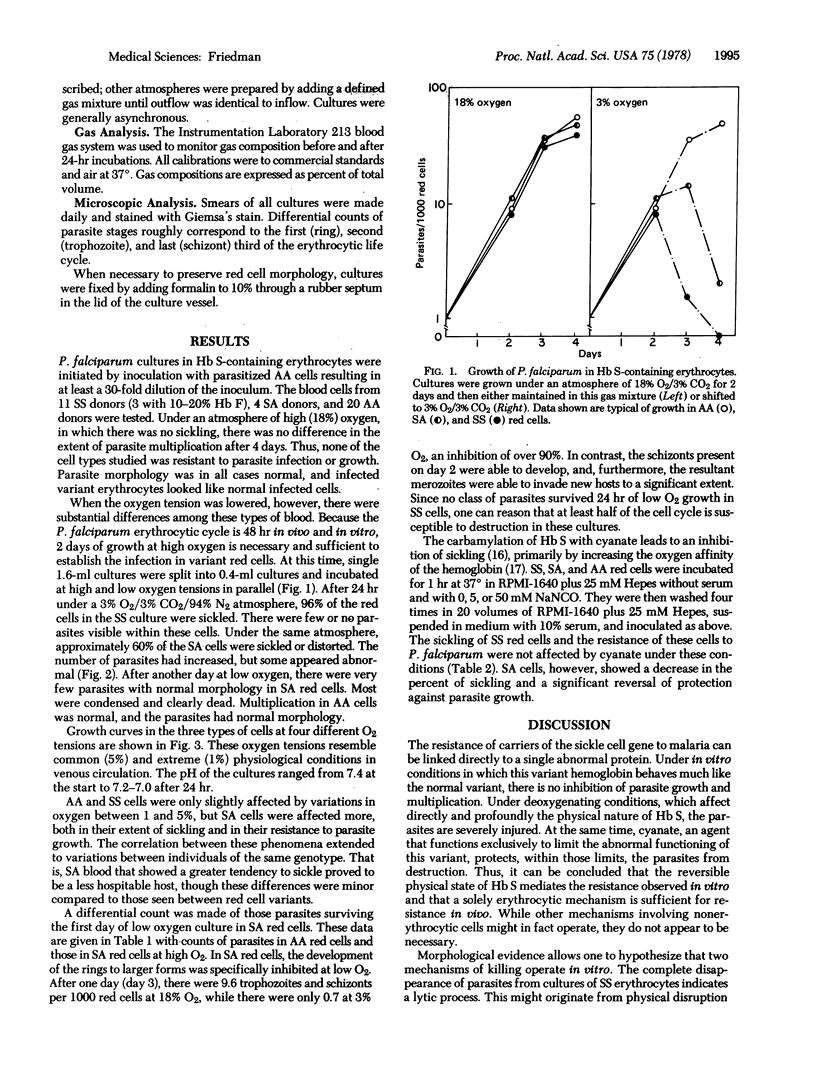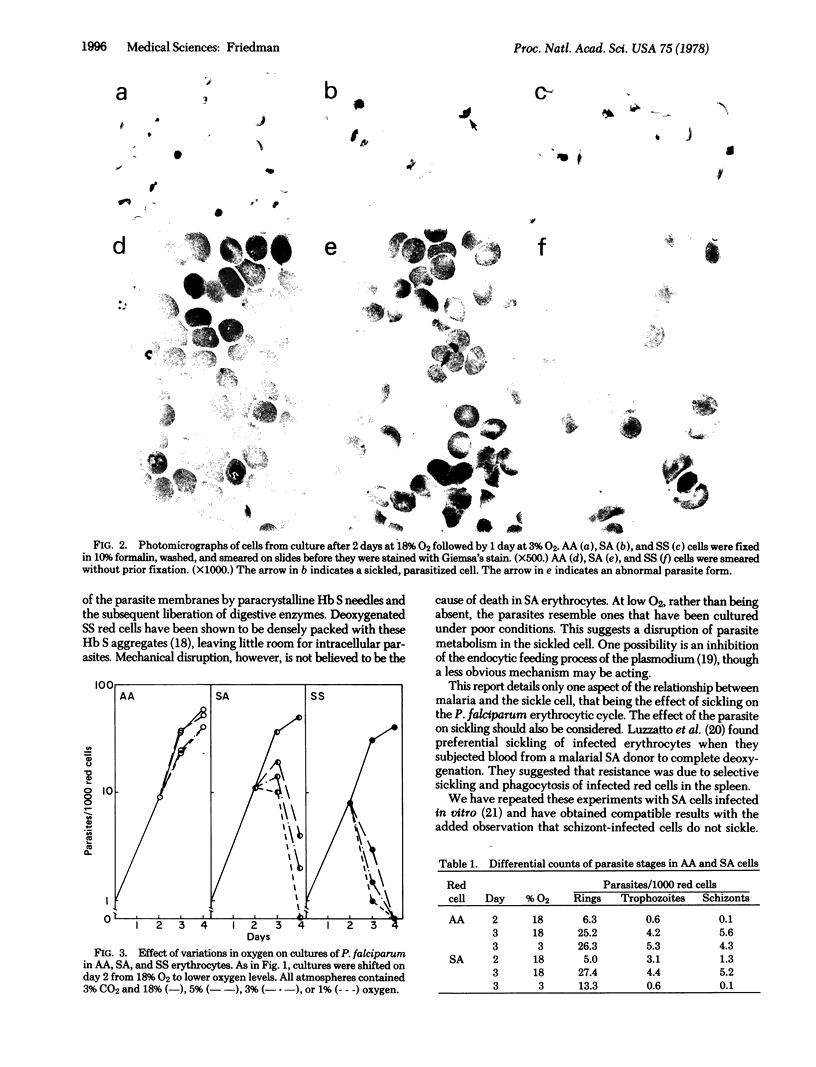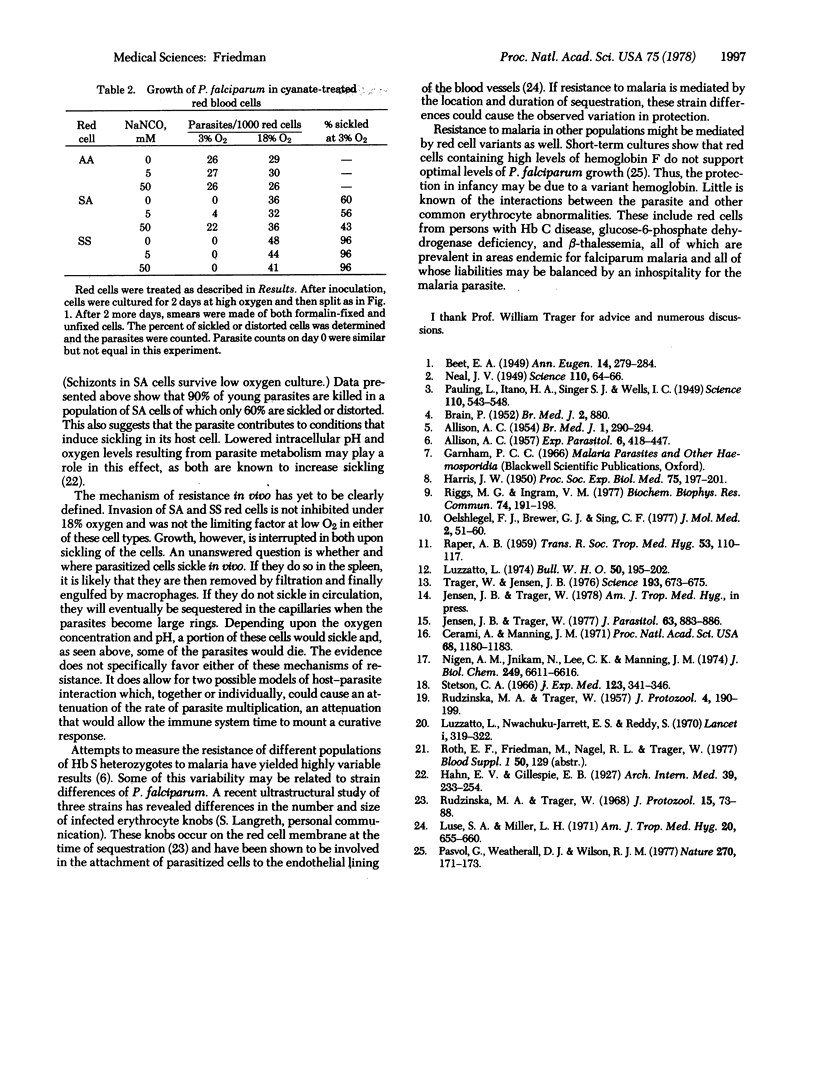Abstract
The physiological basis for the resistance to falciparum malaria individuals with sickle cell trait has not been understood. Recent advances in erythrocytic Plasmodium falciparum culture have made possible a direct investigation of the development of the malaria parasite in cells with sickle cell homoglobin. In a high (18%) oxygen atmosphere, there is no apparent sickling of cells, and the growth and multiplication of P. falciparum is identical in normal (AA), hemoglobin S homozygous (SS), and hemoglobin S heterozygous (SA) erythrocytes. Cultures under low (1-5%) oxygen, however, showed clear inhibition of growth. The sickling of SS red cells killed and lysed most or all of the intracellular parasites. Parasites in SA red cells were killed primarily at the large ring stage, probably as a result of a disruption of the parasite metabolism. Incubation in cyanate prior to culture reversed the resistance of SA erythrocytes to plasmodium growth, but had no effect on SS red cell sickling or resistance. Thus, the mechanism of resistance in vivo may be due solely to intraerythrocytic conditions.
Full text
PDF



Images in this article
Selected References
These references are in PubMed. This may not be the complete list of references from this article.
- ALLISON A. C. Malaria in carriers of the sickle-cell trait and in newborn children. Exp Parasitol. 1957 Jul;6(4):418–447. doi: 10.1016/0014-4894(57)90032-2. [DOI] [PubMed] [Google Scholar]
- ALLISON A. C. Protection afforded by sickle-cell trait against subtertian malareal infection. Br Med J. 1954 Feb 6;1(4857):290–294. doi: 10.1136/bmj.1.4857.290. [DOI] [PMC free article] [PubMed] [Google Scholar]
- Cerami A., Manning J. M. Potassium cyanate as an inhibitor of the sickling of erythrocytes in vitro. Proc Natl Acad Sci U S A. 1971 Jun;68(6):1180–1183. doi: 10.1073/pnas.68.6.1180. [DOI] [PMC free article] [PubMed] [Google Scholar]
- HARRIS J. W. Studies on the destruction of red blood cells. VIII. Molecular orientation in sickle cell hemoglobin solutions. Proc Soc Exp Biol Med. 1950 Oct;75(1):197–201. doi: 10.3181/00379727-75-18144. [DOI] [PubMed] [Google Scholar]
- Jensen J. B., Trager W. Plasmodium falciparum in culture: use of outdated erthrocytes and description of the candle jar method. J Parasitol. 1977 Oct;63(5):883–886. [PubMed] [Google Scholar]
- Luse S. A., Miller L. H. Plasmodium falciparum malaria. Ultrastructure of parasitized erythrocytes in cardiac vessels. Am J Trop Med Hyg. 1971 Sep;20(5):655–660. [PubMed] [Google Scholar]
- Luzzatto L. Genetic factors in malaria. Bull World Health Organ. 1974;50(3-4):195–202. [PMC free article] [PubMed] [Google Scholar]
- Luzzatto L., Nwachuku-Jarrett E. S., Reddy S. Increased sickling of parasitised erythrocytes as mechanism of resistance against malaria in the sickle-cell trait. Lancet. 1970 Feb 14;1(7642):319–321. doi: 10.1016/s0140-6736(70)90700-2. [DOI] [PubMed] [Google Scholar]
- Neel J. V. The Inheritance of Sickle Cell Anemia. Science. 1949 Jul 15;110(2846):64–66. doi: 10.1126/science.110.2846.64. [DOI] [PubMed] [Google Scholar]
- Nigen A. M., Njikam N., Lee C. K., Manning J. M. Studies on the mechanism of action of cyanate in sickle cell disease. Oxygen affinity and gelling properties of hemoglobin S carbamylated on specific chains. J Biol Chem. 1974 Oct 25;249(20):6611–6616. [PubMed] [Google Scholar]
- PAULING L., ITANO H. A. Sickle cell anemia a molecular disease. Science. 1949 Nov 25;110(2865):543–548. doi: 10.1126/science.110.2865.543. [DOI] [PubMed] [Google Scholar]
- Pasvol G., Weatherall D. J., Wilson R. J. Effects of foetal haemoglobin on susceptibility of red cells to Plasmodium falciparum. Nature. 1977 Nov 10;270(5633):171–173. doi: 10.1038/270171a0. [DOI] [PubMed] [Google Scholar]
- RAPER A. B. Further observations on sickling and malaria. Trans R Soc Trop Med Hyg. 1959 Jan;53(1):110–117. doi: 10.1016/0035-9203(59)90093-8. [DOI] [PubMed] [Google Scholar]
- Riggs M. G., Ingram V. M. Differences in erythrocyte membrane proteins and glycoproteins in sickle cell disease. Biochem Biophys Res Commun. 1977 Jan 10;74(1):191–198. doi: 10.1016/0006-291x(77)91393-6. [DOI] [PubMed] [Google Scholar]
- Rudzinska M. A., Trager W. The fine structure of trophozoites and gametocytes in Plasmodium coatneyi. J Protozool. 1968 Feb;15(1):73–88. doi: 10.1111/j.1550-7408.1968.tb02091.x. [DOI] [PubMed] [Google Scholar]
- Stetson C. A., Jr The state of hemoglobin in sickled erythrocytes. J Exp Med. 1966 Feb 1;123(2):341–346. doi: 10.1084/jem.123.2.341. [DOI] [PMC free article] [PubMed] [Google Scholar]
- Trager W., Jensen J. B. Human malaria parasites in continuous culture. Science. 1976 Aug 20;193(4254):673–675. doi: 10.1126/science.781840. [DOI] [PubMed] [Google Scholar]



